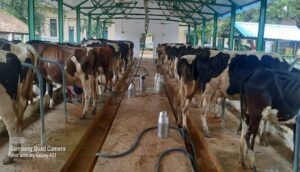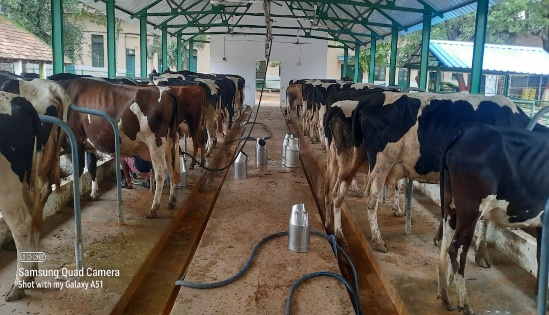DAIRY CATTLE BEDDING: IMPORTANCE AND RECENT ADVANCES
- Praveen
Ph.D. Scholar, Livestock Production Management
Southern Regional Station, National Dairy Research Institute,
Adugodi, Bangalore- 560030.
Abstract
Bedding imparts a required aspect for animal comfort and welfare in terms of lying behaviour, hoof and udder health which improves the production and reproduction performance well. So, this article focusses on various bedding materials used for animals and recent focus on recycled manure solids as bedding materials which were used commonly in foreign countries and its studies on Indian conditions needed to be undertaken. Cement as most commonly used flooring followed by rubber mat, sand, saw dust has been used widely in animal sheds mostly under loose housing systems based on its cost, durability, availability and comfortness. Since 1970s alternative bedding has been pronounced and widely used in foreign countries like USA, European countries called recycled manure solids or green bedding. RMS bedding shown to be more comfortable, cheaply available but it is having some disadvantages over microbial growth due to presence of high organic matter. RMS can be used as alternative bedding in Indian conditions but which needs further research studies.
Keywords: Bedding, Cattle, Recycled Manure Solids.
Introduction
Providing cows with clean, dry and comfortable surface to rest on is important to the well-being of dairy cows as they spend approximately 6-12 hours each day resting (Haley et al., 2000). Previous research shows that free stalls which allow ease of rising and lying moments comfortable bedding are used more by cows. Major factors determining the usage of bedding material includes availability, material handling and storage, manure management system, economics, animal health and comfort, environmental impact on crop production and land application (Niraula et al., 2018). Different types of bedding material have been used till like synthetic mattress, foam mattress (Hultgren and Bergsten, 2001), rubber mats, concrete floor, saw dust, sand, mattress (Weary and Taszkun, 2000), brick floor (Haley et al., 2000), straw, wood shavings with saw dust (Janni et al., 2006), chipped wood, compost bedding (Bewley and Taraba, 2017), paper bedding (Sobte and Buijis, 2021) pine leaves in broiler chicks, flue gas desulphuration gypsum, peat (Ekman et al., 2018) and recently recycled manure solids (Harrison et al., 2008).
According to Alanis et al. (2021), organic manure solid like saw dust has high bacterial load of Streptococcus spp than recycled sand, dry matter content of recycled sand and saw dust are 92% and bacterial counts are high in used samples than fresh samples. Alanis et al. (2021) also found that no association of bulk tank (BT) bacteria counts and bulk tank somatic cell count (BTSCC) with bedding material bacterial count and high level of dry matter in bedding has reduced Streptococcus spp., coliforms and non-coliforms.
Different bedding materials
- Concrete floor: Concrete floors are commonly used flooring (Upadhyay et al., 2021), durable, easily cleaned and reasonably priced but hard and slippery if not adequately cleaned (Albright, 1995). More than 80 % of animals are prone to laminitis either clinically or sub clinically (Somers et al., 2003) due to hard surface (Espejo et al., 2016) with low friction coefficient of 0.35 (Rushen and de Passille, 2006), cement flooring causes disadvantage in walking and standing (Philips and Morris, 2001), high incidence of heel erosion and higher claw growth and wear (Vanegas et al., 2006). Reproductive problems like repeat breeding, dystocia, retained placenta are more common in those animals on concrete flooring (Kara et al., 2015). Animals on concrete floor show low lying time and more standing time (Haley et al., 2000).

Fig 1: Cement flooring
- Saw dust/Wood shavings: They provide improved aeration and compatible (Janni et al., 2006). These are regionally available bedding material and more compatible with manure handling systems (Zdanowicz et al., 2004) but due to increased moisture and manure content with animal use promotes bacterial proliferation (Zehner et al., 1986). Chipped wood would cause injury due to its sharp edges (Bewley et al., 2013). Use of saw dust or straw had reduced incidence and less severe hock lesions (Weary and Taskhum, 2000). Clean udder on the use of saw dust compared with sand (Zdanowicz et al., 2004).
- Sand: Sand are known to be gold standard bedding material (Justice-Allen et al., 2010) due its ability to adopt animals for best lying surface (Calamari et al., 2009) even during hot season in crossbred cows in north India (Madke et al., 2010). Reduced acceptance by cows due to unfamiliarity, unstable sand surface. Usage of washed sand is more comfortable as bacterial growth is reduced due to low moisture content (Hogan and Smith, 2012). Sand does not soak up urine or milk so it does not support bacterial growth (Godden et al., 2008) and result in low incidence of mastitis (Bey et al., 2002), reduced laminitis case or leg or hock injury to animals but have high release of ammonia due to mixing of urine and dung in sand (Leso et al., 2020).
- Straw: Paddy straw or wheat straw or ragi straw were used based on the availability in those areas and it is having more cushioning property than rubber floor with better hoof health (Rutherford et al., 2008).
- Rubber mats: Rubber mats are expensive and also cause claw over growth (Platz et al., 2008). High incidence of mastitis is reported due to soiling of udder of dairy cows (Leso et al., 2020). Increased resting of cows in alleys (Platz et al., 2008), increased standing in feeding area with rubber mats (Tucker et al., 2006). Improved footing, additional cushioning and additional standing time. Incidence of foot related problems like heel horn erosion, dermatitis, white line hemorrhages, sole ulcer, white line separation were reduced (Hultgren and Bergsten, 2001).
- Synthetic /foam mattress: Use of synthetic mattress reduce labour and bedding needs but have disadvantage of decreased lying comfort, increased hock lesions, hoof lesions and lameness. Animal with foam mattress have high hock lesions (Hultgren and Bergsten, 2001) and the prevalence was higher than box compost or horse manure.
- Compost bedding: This can be utilized in hot-humid region with fan but lack of research on its use in tropical climatic regions (Leso et al., 2020) reduced its acceptability. Cows on compost type of bedding provide more milk yield than non- compost bedded animals (Black et al., 2013).

Fig.2: Effects of different flooring on animal performance and health
- Recycled manure solids as bedding
Since 1970s the concept of use of dairy waste solids, separated manure solids which is recently named as green bedding has been used in US (Timms, 2008) by physically separated slurry called recycled manure solids (RMS). They were used as bedding for animals in dry climatic areas as maintaining high dry matter content was easy (Timms, 2008) but due to high bacterial load, rising of temperature of solids to reduce bacterial numbers has been followed (Carroll and Jasper, 1978). Later the use of products of anaerobic digestion of manure has been used as bedding but its cost of production fetch more (Timms, 2008). Now some technical ability has been introduced to produce drier materials with 30% dry matter (that had been adopted in European countries under various climatic regions) (Leach et al., 2015). EC Regulation 1069/2009 defines livestock manures as Category 2 Animal By-products. As a result, their usage as a ‘technical product’ (for example, animal bedding) is only approved under tight circumstances that reduce the health risks. A product derived from animal by-products is described as having a “safe end use” when it is used “under conditions that pose no unacceptable hazards to public and animal health” (Anonymous, 2009). There are four major types of RMS processing systems like green manure- only pressed and dewatered, digested and then pressed, composted manure with rotating drum by mixing solids with hot air of more than 150°F for one day and last is mechanically dried at 700°F at entry and 130°F at exit for 12-15 minutes which gives more dry matter with lower clinical mastitis rate.
Recycled manure solids usually have 35% dry matter and are hygroscopic in nature. Lime or peracetic acid or heat treatment at 50°C of RMS will reduce the survivability of Mycobacterium avium spp. and paratuberculosis. Even though many researchers have reported negative impact of RMS on udder health and mastitis, some researchers observed no relationship between mastitis incidence and neither bacterial nor physical properties of bedding affected mastitis incidence (Harrison et al., 2008). Manure solids has low coliform content (50% in fresh, 54% in used) but 100% Klebsiella present (Alanis et al., 2021).
8.1 Potential benefits of recycled manure solids
- Reduce livestock manure pollution
- Used in deep bedded stalls and on top of mattress, decreased bedding costs, comfort to cows (Green et al., 2014)
- More than 14 days storage will reduce bacterial count which is suitable for bedding
- Long lying time and fewer hock lesions than sand, paper, sawdust. Lower dust level than chopped straw or sawdust
- No connection between RMS bedding and high SCC or clinical mastitis. Soft, non-abrasive, readily available (Leach et al., 2015)
- Low prevalence of lamesss and hock lesions than herds with mattresses. Clean stall surface of animal bedding area
- Hooves of cattle housed on RMS were dry, which is likely to be beneficial for foot health
8.2 Potential risks of recycled manure solids
- Cows on RMS are dirtier than those on sawdust or wheat straw. Klebsiella sp concentration is more in RMS
- Wide distribution of environmental mastitis pathogen like coli, Klebsiella and Enterobacter and to less extent Citrobacter (Ostrum et al., 2008)
- High degree of non-functioning mammary gland and discarded milk with increase in SCC
8.3 Major pathogens of recycled manure solids: Bacillus cereus, E. coli, Mycobacterium bovis (Harrison et al., 2008), Salmonella sp, Klebsiella sp, Streptococcus uberis
Bedding impact on udder health
Bovine teat skin act as reservoir for Staphylococcus aureus, Streptococcus uberis and coliform bacteria. Paduch et al. (2012) reported that teat end hyperkeratosis was associated with environmental pathogens and not with Staphylococcus aureus loads. High bacterial levels in bedding like Coliforms, Klebsiella spp., Staphylococcus spp., Streptococcus and Streptococci like species (SSLO) were associated with increased mastitis risk (Patel et al., 2019). Use of 30 cm depth of paddy straw as bedding material over concrete floor increased the milk yield and reduced somatic cell count, pH, electrical conductivity on 20 and 30 cm depth bedding material (Singla et al., 2012). Mechanically composted RMS had improved udder health and dry RMS had improved milk production on comparison with digested or green solids. Composted recycled manure solids helped in reducing tetracycline resistant gram-negative bacteria as well as increasing the ash which can be used as free stall bedding with minimal environmental mastitis pathogen exposure to teat ends. Also reduced coliforms and Streptococcus bacteria in composted recycled manure on day 0 and klebsiella on day 0 and 6 compared with fresh RMS (Cole, 2015).
Bradley et al. (2018) in A cross-sectional study of 40 farms with recycled manure solids found no evidence of increased risk of presence of Y. enterocolitica, Salmonella spp. or L. monocytogenes in milk and also quoted that though high bacterial load in RMS, its bacterial load is not necessarily associated with the milk bacterial load than the use of sand or saw dust. Harrison et al. (2008) observed some farms with increased and some farms with decreased BMSCC in RMS converted farms. Leach et al. (2015) with several studies and collation of data concluded that there is no consistent impact on SCC of the use of RMS. Better bedding for animals can be provided with maintaining strict hygiene, milking practice and applying required strategies for risk mitigation (Leach et al., 2015).
Impact of bedding on lying behaviour
Lying surface either hard or soft flooring decides lying behaviour of animal, with soft bedding aids increase in lying time of animals by providing more comfort to animals. Cows in rubber mat at covered area had more lying rumination and sleeping time and those in sand bedding at open area had reduced standing and standing rumination activity with increased sitting or lying time (Upadhyay et al., 2021) with conclusion of favorable area of rubber mat in covered and sand in open area. Kull et al. (2017) observed increase in lying time, lying bouts and total steps on recycled sand bedding of lactating Holstein dairy cows. Straw bed and rubber mattress were compared as bedding and more preference was given by animals for straw bed but there was no difference in lying time among bedding materials.
Impact of bedding on animal hygiene
Van Gastelen et al. (2011) compared different bedding materials like compost, sand, horse manure and foam mattress where foam mattress caused least severe hock injury, but no difference in cleanliness score among all bedding materials. The use of mattresses or waterbed and sand as bedding material and observed clean leg and udder hygienic score on mattresses or waterbeds. Cow dung bed floor was most comfortable than rubber mat floor in terms of hock score and Gurung et al. (2020) also reported better hock score in cow dung bedding followed by rubber mat, concrete floor and sand. No difference in cleanliness score, comfort, bedding bacterial growth was observed on use of deep bedded straw lime and miscanthus (silver grass) usage as bedding materials (Van Weyenberg et al., 2015). Deep layer of bedding associated with less hock lesions and claw lesions. Though RMS bedded cows are less dirty than other bedding materials except compost, it does not mean absence of pathogens, so before milking teat cleaning should be done (Husfeldt and Endres, 2012). No difference in cleanliness score, comfort, bedding bacterial growth on use of deep bedded straw lime and miscanthus (silver grass) usage as bedding materials (Van Weyenberg et al., 2015)
Impact of bedding on hoof health
Hard slippery floor had short strides, wide posture and asymmetric steps, but sand and rubber mat are soft textured and provide more pronounced lameness diagnosis than on concrete flooring and reduced wear, positive net growth of hoof, preserved sole concavity. Animal in RMS bedded houses have dry hooves and better foot and leg health on composted RMS (Timms, 2008), prevalence of lameness was 13-16% in deep beds, 18-22% in mats (Husfeldt and Endres, 2012). Endres (2017) reported that confinement housing can result in reduced cow comfort and greater incidence of lameness when increased exposure to hard flooring surface and exposure of teat to moisture and manure in confinement leads to development of infectious foot lesions like digital dermatitis and foot rot.
Conclusions
Different bedding materials have been reviewed in this article and its impact on udder health, lying behaviour, animal hygiene and hoof health has been stated. Soft bedding provides comfort to animals in terms of lying behaviour and hoof health. Bedding with minimal microbial load and frequent dung removal from floor, periodical bedding change provides good indication on udder health and animal hygiene. Recent low-cost recyclable bedding material like RMS can be used on cattle for their comfort and welfare.
References
- Alanis, V.M., Zurakowski, M., Pawloski, D., Tomazi, T., Nydam, D.V. and Ospina, P.A. (2021). Description of the characteristics of five bedding materials and association with bulk tank milk quality on five New York dairy herds. Frontiers in Veterinary Science, 8: 636833.
- Albright, J.C. (1995). Flooring in dairy cattle facilities. In International Conference on Animal Behavior and the Design of Livestock and Poultry Systems, Indianapolis, IN. Northeast Regional Agricultural Engineering Service, Cooperative Extension, Ithaca, New York,168-182.
- Bewley, J. and Taraba, J. (2017). Compost bedding pack barns for dairy cows – 2017 Webinar – 70 Minute Recording. https://eurodairy.eu/webinar-compost-bedded-pack-barns-dairy-cows-usa-knowledge-experience/.
- Bewley, J.M., Taraba, J.L., McFarland, D., Garrett, P., Graves, R., Holmes, B. and Wright, P. (2013). Guidelines for managing compost bedded-pack barns. The Dairy Practices Council. https://www.dairypc.org/catalog/guidelines-for-managing-compost-bedded-pack-barns.
- Bey, R.F., Reneau, J.K., Farnsworth, R.J. (2002). Manage bedding to control bacteria and reduce udder infections, Minutes on Dairy Health Conference in College of Veterinary Medicine, University of Minnesota, St. Paul, 103-113.
- Black, R.A., Taraba, J.L., Day, G.B., Damasceno, F.A. and Bewley, J.M. (2013). Compost bedded pack dairy barn management, performance, and producer satisfaction. Journal of Dairy Science, 96: 8060-8074.
- Bradley, A.J., Leach, K.A., Green, M.J., Gibbons, J., Ohnstad, I.C., Black, D.H., Payne, B., Prout, V.E. and Breen, J.E. (2018). The impact of dairy cows’ bedding material and its microbial content on the quality and safety of milk–A cross sectional study of UK farms. International Journal of Food Microbiology, 269: 36-45.
- Calamari, L., Calegari, F. and Stefanini, L. (2009). Effect of different free stall surfaces on behavioral, productive and metabolic parameters in dairy cows. Applied Animal Behaviour Science, 120: 9-17.
- Carroll, E.J. and Jasper, D.E. (1978). Distribution of Enterobacteriaceae in recycled manure bedding on California dairies. Journal of dairy science, 61: 1498-1508.
- Cole, K.J., (2015). Bacterial counts in composted and fresh recycled dairy manure bedding, Doctoral dissertation, The Ohio State University.
- https://www.pashudhanpraharee.com/management-of-dairy-cattle-during-winter/
https://en.engormix.com/dairy-cattle/articles/advantages-bedding-material-dairy-t42736.htm


